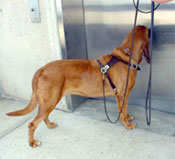AMAZING
STORIES FROM THE FBI LAB
The Survivability of Human Scent
09/29/04
 We
thought you'd like to know that the new
issue of Forensic Science Communications has just
been published on our site. And it's full of fascinating
stuff.
We
thought you'd like to know that the new
issue of Forensic Science Communications has just
been published on our site. And it's full of fascinating
stuff.
Take the article on the
Survivability of Human Scent by Rex Stockham,
Dennis Slavin, and William Kift. Rex is an examiner
in our Explosives Unit; Dennis and Bill are bloodhound
handlers for the South Pasadena PD and the Long Beach
PD in California, respectively. These three worked
together to develop a new approach to identify bombmakers
and arsonists through human-scent evidence recovered
from post-blast debris. Their feasibility study shows
that human-scent evidence left by bomb handlers lasts...and
can be used to identify them even after undergoing
the extreme mechanical and thermal effects of an explosion
or burning.
All you need is a good
scent-recovery process and a team of highly trained bloodhounds and handlers.
A little background. Human-scent
evidence is, by its very nature, fragile and easy to compromise. But just
last year Jeff and Lisa Harvey demonstrated that technology can reduce
its fragility by using Scent Transfer Units to transport the components
of human scent onto sterile surgical pads. They then proved that trained
bloodhounds could identify that scent and match it to a suspect, even days
later and on contaminated trails through an urban environment.
This study takes
those results one step further. Here's a simplified overview:
four pipe bombs and two gas containers were handled by six test subjects
for one to two minutes. The explosives were detonated or burned; the
debris collected; and this evidence was processed by a Scent Transfer
Unit onto sterile surgical pads, which were then aged for anywhere between
two and 16 days. Each bloodhound handler was then arbitrarily given a
scent pad to present to a dog.
Now the test. The bomb
handlers and six innocent "decoys" were sent out onto trails
in an urban public park. The bloodhounds were placed at the start of a
trail, given a good sniff of a scent pad, and off they went--using their
specially trained "yes" or "no" response to signify
a match or no match.
The results? Overall,
the dogs correctly identified the target person in 53 of the 80 bomb-debris
experiments and 31 of the 40 arson-debris experiments with no false identifications.
These are good results, supporting the general reliability of the procedure
and indicating potential use in criminal investigations.
Interested
in the details? Go straight to the
Survivability of Human Scent. And while you're
there, you may want to look at some other research
articles too.
Links: The
FBI Laboratory


